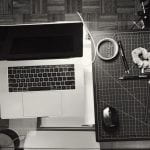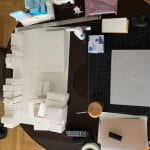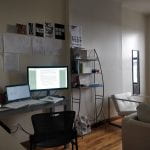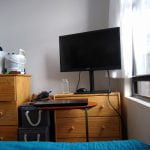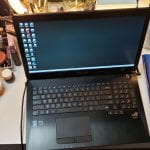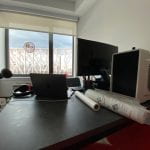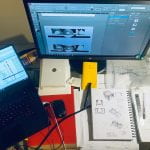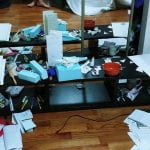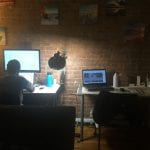The Cornell M.Arch 4th semester typically consists of varied in-person experiences from one of the world’s most prominent urban centers. It is a semester full of site visits, firm tours, and lectures on structure, fire egress stairs, and professionalism. With the shift to screen-learning, there have been a number of unprecedented experiences that have changed our outlook on architecture as we know it. We interviewed some of the students to get a peek into their new lives and find out what major takeaways can be associated with this shift.
Describe your set-up and your daily routine.
Jully Chen: I work on a small table by my mattress. On it is a cutting mat, which I mainly use as a mouse pad. Each day is more or less the same. Wake up, make food, watch hours of Bon Appetit test kitchen videos and work. It’s a familiar but strange condition to live in. I feel very lethargic, but eager. There is a constant shift between these two feelings.
Riana Tan: My setup is just a cutting mat and my own site model that I don’t even use on my dining table. Thankfully, I have enough room to set-up a work space. I wake up, take a shower, make coffee, then sit down and try to write what I have to do for the day. I work then eat in between. I pretty much do what I feel like doing in the moment, which is a result of not having anywhere to be.
Byungchan Ahn: I live with Angel and Jeniffer, both of whom went back to Florida. So, I work alone in my living room. I wake up, at around 8:00 a.m. or so. I try to do some exercise in my room, 20 – 30 mins., then get coffee, and write for 15 minutes. I started keeping a journal to not go so crazy without contact with anyone and it’s helping me channel a lot of negative energy. I figure out what times the classes are that day and when to cook around those times. Work day, cook night, go to bed; it gets pretty repetitive. Nothing out of the ordinary is happening any more.
Angel Almanzar: My setup switches between bed and desk. It’s so hard working in my bed every so often. Also I share space with my girlfriend, so sometimes we switch and I go to bed and she uses the desk. I have no model-making space. In addition to that, since Florida is in a lock down, it means many of the material and craft stores are closed since they are non-essential. I obviously didn’t bring the museum board on the plane from the City.
Eli Maroscher: I have a very small little side table, I put my laptop on that. I have the school monitor on my dresser and use the dining room chair in my bedroom. It’s a crazy-cramped little space. For my routine, I get up in the morning, I make breakfast and get my day started a little earlier, 8:30 or 9:00. It’s nice to not lose time commuting. Around 5:30 pm I workout and then make dinner with my roommates and fiance. We are all working remotely so we’re all here throughout the day. We slip into our own rooms to juggle meetings and classes. My room’s jokingly nicknamed the corner office.
Everybody is abiding by the shelter at home initiative, but we are located at the epicenter. In your opinion, do you feel any difference?
Riana Tan: I feel the difference when I watch the news and read updates. If I didn’t, I wouldn’t really know the difference. Every day at 7:00 pm everyone starts an applause for the front liners. Before, not everyone was participating but now a lot more do. I hear the sounds get louder and louder as each day passes, which to me indicates a change, whether it be a change in how many more people are staying in or how people express their appreciation to the front liners (applause, horns, pots, pans).
Allexxus Farley-Thomas: I live in The House on Roosevelt Island and I feel pretty separated from the typical activity of Manhattan or Brooklyn or Queens. I feel a sense of hyper-awareness; I don’t feel panic or over-concern, but I feel much more aware. I feel myself moving away from people as I’m walking and I know when I’m touching my face. I wonder: how have we adapted so quickly? The situation is uncomfortable and frustrating, but we are learning to live with it. It makes me think of climate change. How can we adapt to a situation if we didn’t have the choice? If we suddenly had to produce less waste or become more sanitary, it’s like another parameter to make better decisions for the environment and public health.
Byungchan Ahn: Yes, I do. Especially compared to Ithaca. Social distancing is so much easier where it’s less dense…you can go outside without meeting anybody anyway. In New York, there’s no nature that’s readily accessible. There’s anxiety associated with that. When I go outside, there’s still a lot of people out there for leisure, which confuses me.
Jully Chen: It’s difficult for me to imagine because this is all we know. We don’t have a point of reference to being sheltered in another place. I often think back to our initial reactions to the shift. Most of us felt anxious and uncertain of whether we could effectively translate our learning to a digital platform. What has been comforting to witness is how quickly we are able to adjust to the new normal. The anticipation of the change can feel more jarring than living and adjusting to the changes day by day. Daily news coverages are stark reminders of how important it is to stay inside and be conscious of how our individual behaviors affect the community. It feels increasingly heavy as the weeks go by.
Jeniffer Carmona: I feel like when I was considering moving it was because I understood how NYC worked. Just seeing the news, it was clear that this pandemic was coming to us. Everybody was getting infected. In just two weeks everything in the city had gotten really bad. Predicting that, I knew I needed to get out now. It’s such a silent thing. I don’t think you’re really affected by the reality until you see it in person at places like the airport. It’s a weird concept, like a ghost. I felt more paranoid, so that’s why I left. I didn’t want to get stuck. My parents were really concerned because I have asthma. My dad told me “you’re literally in an infected city.” I just felt like I was unsafe. My parents said it was up to me. When thinking that I could get infected I was reminded of the feeling of not being able to breathe and I was really scared of that. I did everything in my power to not have to go through that. I had to run away from the danger.
Angel Almanzar: I came to Florida because at the time everything was happening to me I didn’t think I could get the care I needed. I was having health complications and I was scared the airports would close down. I didn’t want to be stuck and then try to travel in the city. I didn’t want to be in the epicenter. There was no way this was going to pass in over a week or a month. We’re going into what? Month 2 of the lock down? Commuting in NY is not sanitary, you don’t know where everyone’s coming from or what they’re exposed to. In Orlando, everyone is in their car and there is minimal exposure.
What are some positive takeaways associated with the shift?
Jeniffer Carmona: With the studio classes, I think our professor has completely devoted himself to us. Since any conversation is only a call away, we have gotten twice as many interactions with him as we would have before. It’s typically not considered okay to FaceTime your professor but now it is. The new relationship you have with the professor is amazing. He knows your project in depth, he sketches over your work and drawings online. Another thing is health. In a way I feel like I am always running in architecture school. Being home reminds me that I have to take care of myself more. I eat better, also because my mom is here and she makes sure I eat. I no longer skip meals.
Angel Almanzar: I think a positive is that we are learning the skills to cohesively present our projects. Now you have to think about your project step-by-step. Typically, you’ll put your plan in the top right corner of your pin-up presentation just because the layout is better, but now you have to form a linear narrative about your design intentions. You’re not jumping around a pin-up board. You’re building up your narrative and there you can clearly see where your narrative falls apart.
Eli Maroscher: There’s some truth to the fact that architecture practice is going to be remote. If you have to work on a project in a different state you don’t go out to it every week. In that regard, it’s good. If you’re in an office though, you’d learn from your co-workers about best practices, so there’s a real challenge to be resourceful right now.
Allexxus Farley-Thomas: Having this ongoing dialogue of architecture in my ears is a little concerning but a great advantage. These individual lessons, or learning moments, are now accessible to everyone. Now, we don’t miss anything. We always know what everyone else is doing, for better or worse. Before zoom, we were all brainstorming individually with nuanced ideas. Now it’s a playing field of the same body of knowledge. The drawback is the consistent flow of voices. Whether or not I’m engaged in that particular conversation, there is a running audio of architecture voices. Our interactions have become almost too efficient. It’s not random or impromptu anymore. It’s so weird to have to set up conversations. It’s not like I can slide a sketch in front of Freddo. We have to set up a meeting for informal interactions.
Riana Tan: I don’t have to commute to the studio, I would usually spend 30-40 minutes commuting. I can wake up 5 mins before class now, which is nice. I am saving more money because I cook more. Classes-wise, I like the format for the studio a lot because it motivates me to prepare something every week in the form of a deck. It makes me become more organized instead of just vomiting sketches at professors during desk-crits. There’s really no coherent thought in that, but when you know you need to prepare something on the screen it helps focus the attention on what you want feedback on.
In your opinion, how will the overall field of architecture change in the next year?
Jeniffer Carmona: Academically, I feel that the idea of professionalism and scheduling will change the most for students. Everything has become scheduled and more rigid. If I want to talk to Freddo, I have to schedule a meeting and make an appointment. When you are in the field, everything is scheduled into meetings. As a student you thrive in that casual studio environment. It’s like we were introduced to the professional realm as students. This semester is about professional practice. Even the way we are talking to our professors and showing our work is more professional. The line between student, academic and professional is becoming more blurred.
Angel Almanzar: Everyone is talking about essential vs. nonessential. In my elective class, we discussed the idea of if the architect is essential. In a time like this where do you place the architect? We build spaces. When you think about it, are we necessary? But at the core, we are designers. With the situation, public space is going to be the most pivotal design challenge because how do you create space where the individual feels safe? Now when you think about a project you need to think of general safety, no small spaces or tight corridors. I was at the grocery store and the guy behind me at the checkout line made it known how far he wanted to stay from me. How do we remove that fear as a designer. We have to create safe and successful public spaces. Right now, all of the places that are typically packed are currently empty. How do we as architects fix this?
Eli Maroscher: The most immediate impact will be that the economy will not recover super fast. Companies will not be investing capital into buildings. Everything will become more competitive. It will be a tough time. Long term, this could be impacting the way people work outside of architecture. Maybe a lot of companies will realize that they can accommodate remote work more easily than they would have thought. It seems that architecture is going to have to think in a non-traditional way about how spaces may be used. An obvious example is that small apartments may need to double as little offices. More generally it may change the way we think about programming and the flexibility of spaces.
Allexxus Farley-Thomas: Architecture is such a long game. It takes years to pull off projects, especially at a large scale. I was thinking of architecture post-COVID almost as interventions. Architecture is going to start taking on a different scale. “Why are you guys doing such big buildings?” was the feedback we heard as a studio from the final review last semester. This new architecture needs to happen at the scale of the body and not necessarily the scale of 300 bodies. We will need other ways to deal with these public health issues, especially when it comes to cleanliness. This scalar issue should start looking at materials and ways that we can produce new environments in existing spaces. Even the park or movie theater, where we were used to being in close proximity will change. What will these spaces feel like?
What is one obstacle that you haven’t been able to get past?
Jeniffer Carmona: It’s not a physical one but that I was very upset when everything happened. It was my dream to live in the city. Even simply walking. The crit rooms and spaces we had were amazing. Having that being taken away was really hard. I felt very angry initially. Then thinking back on it, it isn’t a big deal compared to people’s health. I still, in a sense, feel like I was being robbed of the experience. But so are people who had a wedding planned or families that haven’t seen their newborns yet. It is hard to compare situations but I will always feel like I missed out on our NYC experience. I try to think of the bigger picture but it’s still too sad for me.
Allexxus Farley-Thomas: The obstacle is more of a mental one. It’s the anxieties about the future that’s putting a huge blockade in front of the present. That obstacle prevents me from focusing on the now and focusing on my project that I can put in my portfolio. What will happen will happen no matter how much I can rationalize for myself. Some days it hits me that this whole thing just suddenly flipped inside out. But the flip side is that I’ve been very motivated to make a strong project right now. I’m trying not to look too far into the future because nothing is certain. Everything is in flux, changing at a rapid pace.
Riana Tan: Not having the facilities. If I have a vision for a model that would require a laser cutter, a shop or a 3D printer, it becomes an obstacle because then I have to find an alternative medium of presenting this idea or visualizing a detail. It does encourage flexibility and creativity in presenting, which I think is a good skill to have. I also miss having a space separate from home to work in. It’s hard to stop myself from working when there is no physical separation. In the past, when I come home from the studio, I know I’m not going to work because I’m home. When you’re working in the same space you live, it’s hard to compartmentalize that.
WIlliam Beal: I think it’s hard gauging how productive you need to be, you don’t have that barometer anymore. When you’re around others you have that “busy-bee” syndrome that you get work out of. I’m still getting work done but I feel like I could be more efficient, but I really don’t know. Maybe I am being more efficient but I’m second guessing myself. Also, it would be nice to have a space to build models and make a mess.
Byungchan Ahn: That’s a tough question. I can’t print anything. Every image that we present has to follow a very linear narrative when we present over Zoom. This medium is like a funnel or a vacuum… it enhances but it also strips away a lot. In a way it’s a good thing to clarify your narrative but something is lost when you can’t present multiple images at the same time or when you can’t Zoom in when you’re presenting something. Also, there’s something nice about redlining drawings in person. There’s something lacking about this in the new digital reality.

